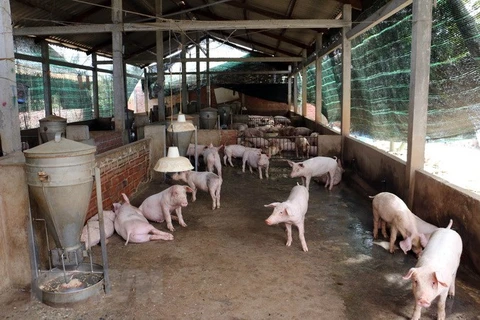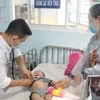 Nearly 25,000 pigs have been culled in an attempt to stop the spread of African Swine Fever to the south (Photo: VNA)
Nearly 25,000 pigs have been culled in an attempt to stop the spread of African Swine Fever to the south (Photo: VNA) Hanoi (VNS/VNA) - African Swine Fever (ASF) has spread among 20 provinces and cities in Vietnam with nearly 25,000 pigs culled in an attempt to stop the disease from reaching the southern farms that produce the industry’s largest amount of pork.
Vietnam News had an interview with Dr. Albert T.Lieberg, Representative of the UN Food and Agriculture Organisation (FAO) in Vietnam, on prevention and response plans.
Q: What is your assessment of Vietnam’s efforts to respond to and prevent the further spread of African Swine Fever (ASF)?
A: The Vietnamese Government has been preparing to combat ASF since August 2018 when the virus affected large part of China. In particular, a prevention plan was formulated in November 2018 to combat ASF including a response plan to address a possible outbreak within the country. The Government has been proactively engaged which is a very positive condition for being able to address the situation properly.
According to my observation and information, the Government has been responding very quickly at both national and provincial levels with a number of different activities. Two of the important ones in terms of direct and immediate needs are the culling of animals affected by the virus and to stop moving pigs by transport through provinces.
Up to now the Government and all stakeholders have succeeded in limiting, geographically speaking, the outbreaks in the northern part of Vietnam.
Q: What are FAO’s recommendations to enhance the ASF response capacities of Vietnam and prevent its further spread?
A: While we have made recommendations, the Government has also by itself decided to tackle the situation in a multi-sectorial way. The situation is not only of concern to producers themselves and the agriculture segment but also to a number of other economic sectors, such as the food and restaurant industry for example.
The establishment of an inter-ministerial committee or working group is on its way. I think it is a very intelligent way to tackle the situation.
In our experience, an element which is often neglected in other countries in similar situations is to think about the endangered livelihoods of many people involved in the sector and sub-sectors who may lose their income source or part of it. How can they keep on making a living? How can these families basically go ahead with their livelihoods – in the short and medium term?
The Vietnamese Government has been proactive in implementing compensation schemes depending on the area and the market situation. The producers are compensated in some locations with around 80 per cent of the market value per kg of lost produce.
I would like to also highlight the recommended zoning approach which means to reduce the movement of pigs through locations from one area to the other.
Another element I want to mention is biosecurity standards. The biosecurity has to be scaled up on all fronts at larger farms and small households. It is fundamentally important that biosecurity standard operating procedures are applied also for those workers who are currently working in response to the situation - we can call them response workers.
Q: The FAO had called on Vietnam to declare a national emergency. Why do you think this is necessary? Could you elaborate on the criteria for the national emergency declaration?
A: Let me clarify. Generally, we at FAO talk about such a declaration of an emergency at national scale if the disease is going to have a dramatic impact on the economy, on a high percentage of the population and on food security in particular, and imminently affecting neighboring countries.
Depending on the development of the magnitude of the disease impact in Vietnam, we suggest strongly that the Government observes and evaluates the situation closely and continuously. In this context, we need to verify on the daily basis to what extent, if and when, there is a need by the Government to establish a high institutional level of alert.
There are roughly 2.6 million household level producing units in Vietnam, multiplied by three to four people per household, we arrive at a substantial number, say 10 million people who, in the worst case, could be potentially affected by the outbreak. Obviously, their income mostly depends on several sources but still pig farming is significant.
In addition, you have roughly another 1,700 commercial units or bigger farms in Vietnam. Here we are talking about another large number of workers depending entirely on the income from the sector.
These few figures already show that there is a very big potential of households and people who could become affected by the outbreak in a worst case scenario. Therefore, we have to be very vigilant about the situation.
For the time being the outbreak is at an initial stage but experience in other countries shows that the virus can develop dramatically, exponentially in a few days and few weeks. But we are confident that the Government is well placed to being able to control the situation. FAO will do its best to support the Government and the people of Vietnam – in particular assisting the affected rural households.
If this infectious disease should further spread to neighbouring countries or to the region, such a situation could then be called an emergency which would then need to be addressed in a collective way by the concerned governments of the affected countries.-VNS/VNA
Vietnam News had an interview with Dr. Albert T.Lieberg, Representative of the UN Food and Agriculture Organisation (FAO) in Vietnam, on prevention and response plans.
Q: What is your assessment of Vietnam’s efforts to respond to and prevent the further spread of African Swine Fever (ASF)?
A: The Vietnamese Government has been preparing to combat ASF since August 2018 when the virus affected large part of China. In particular, a prevention plan was formulated in November 2018 to combat ASF including a response plan to address a possible outbreak within the country. The Government has been proactively engaged which is a very positive condition for being able to address the situation properly.
According to my observation and information, the Government has been responding very quickly at both national and provincial levels with a number of different activities. Two of the important ones in terms of direct and immediate needs are the culling of animals affected by the virus and to stop moving pigs by transport through provinces.
Up to now the Government and all stakeholders have succeeded in limiting, geographically speaking, the outbreaks in the northern part of Vietnam.
Q: What are FAO’s recommendations to enhance the ASF response capacities of Vietnam and prevent its further spread?
A: While we have made recommendations, the Government has also by itself decided to tackle the situation in a multi-sectorial way. The situation is not only of concern to producers themselves and the agriculture segment but also to a number of other economic sectors, such as the food and restaurant industry for example.
The establishment of an inter-ministerial committee or working group is on its way. I think it is a very intelligent way to tackle the situation.
In our experience, an element which is often neglected in other countries in similar situations is to think about the endangered livelihoods of many people involved in the sector and sub-sectors who may lose their income source or part of it. How can they keep on making a living? How can these families basically go ahead with their livelihoods – in the short and medium term?
The Vietnamese Government has been proactive in implementing compensation schemes depending on the area and the market situation. The producers are compensated in some locations with around 80 per cent of the market value per kg of lost produce.
I would like to also highlight the recommended zoning approach which means to reduce the movement of pigs through locations from one area to the other.
Another element I want to mention is biosecurity standards. The biosecurity has to be scaled up on all fronts at larger farms and small households. It is fundamentally important that biosecurity standard operating procedures are applied also for those workers who are currently working in response to the situation - we can call them response workers.
Q: The FAO had called on Vietnam to declare a national emergency. Why do you think this is necessary? Could you elaborate on the criteria for the national emergency declaration?
A: Let me clarify. Generally, we at FAO talk about such a declaration of an emergency at national scale if the disease is going to have a dramatic impact on the economy, on a high percentage of the population and on food security in particular, and imminently affecting neighboring countries.
Depending on the development of the magnitude of the disease impact in Vietnam, we suggest strongly that the Government observes and evaluates the situation closely and continuously. In this context, we need to verify on the daily basis to what extent, if and when, there is a need by the Government to establish a high institutional level of alert.
There are roughly 2.6 million household level producing units in Vietnam, multiplied by three to four people per household, we arrive at a substantial number, say 10 million people who, in the worst case, could be potentially affected by the outbreak. Obviously, their income mostly depends on several sources but still pig farming is significant.
In addition, you have roughly another 1,700 commercial units or bigger farms in Vietnam. Here we are talking about another large number of workers depending entirely on the income from the sector.
These few figures already show that there is a very big potential of households and people who could become affected by the outbreak in a worst case scenario. Therefore, we have to be very vigilant about the situation.
For the time being the outbreak is at an initial stage but experience in other countries shows that the virus can develop dramatically, exponentially in a few days and few weeks. But we are confident that the Government is well placed to being able to control the situation. FAO will do its best to support the Government and the people of Vietnam – in particular assisting the affected rural households.
If this infectious disease should further spread to neighbouring countries or to the region, such a situation could then be called an emergency which would then need to be addressed in a collective way by the concerned governments of the affected countries.-VNS/VNA
VNA























